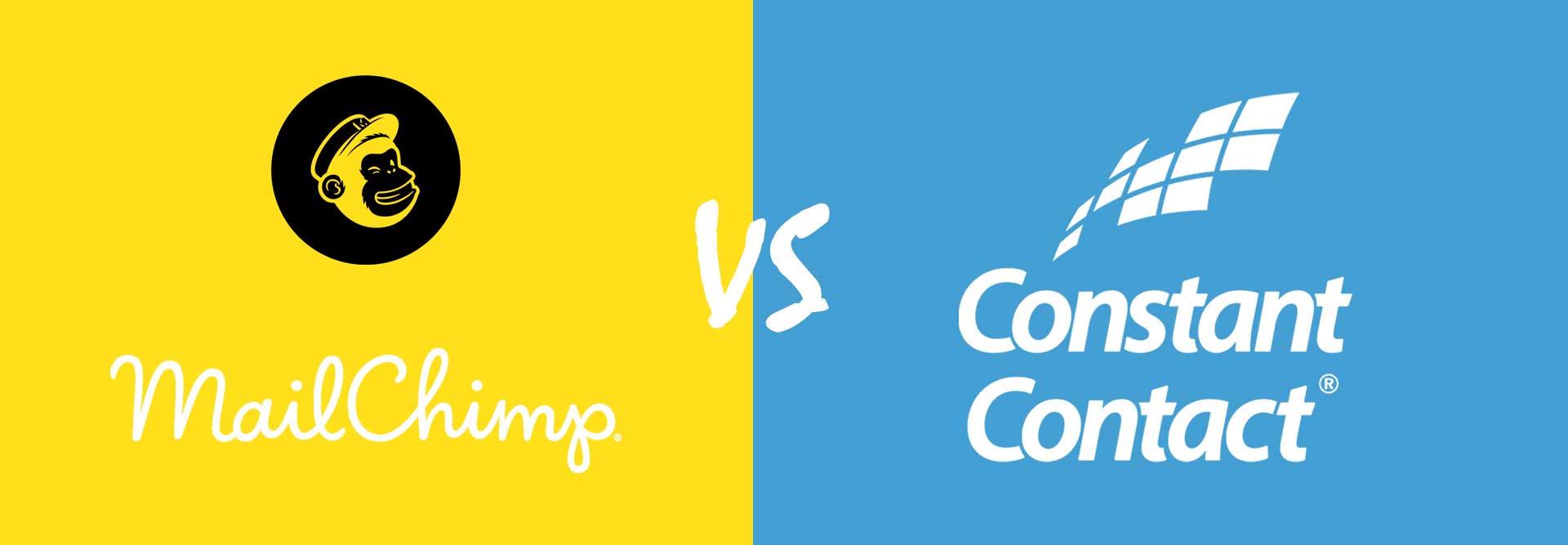
Mailchimp vs Constant
The two most well-known and popular email marketing platforms in the industry today are Constant Contact and Mailchimp.
At first glance, both are pretty similar and the differences between them are minor in terms of functionality and features. But even slight differences can impact the delivery of your message and your email marketing strategy, so you need to choose the one that works best for you.
We’ve performed a comprehensive review of both Mailchimp and Constant Contact, used them both extensively, and highlighted the pros and cons of each platform to determine which one is best.
The verdict?
We love Mailchimp, but Constant Contact is definitely the better email marketing platform at the moment for most businesses and startups – with room for some adjustments that we’ve mentioned below.
Our results were based on a comparison of the features, user interface, support, pricing, reputation, client satisfaction and the overall industry performance of each platform.
Our goal is to help you find the information you need to determine whether Mailchimp or Constant Contact is the right platform for your business.
- Template and Design Features
- Analytics and Reporting
- Deliverability and Performance
- Pricing
- Support and Knowledge Base
Here’s some quick stats before we get started
| Constant Contact | Mail Chimp | |
| Established | 1995 | 2001 |
| Headquarters | Waltham, Massachusetts | Atlanta, Georgia |
| Revenue | $332 million | $400 million |
| Employees | 1,235 + | 550+ |
| Customers | 5 million | 14 million |
| Type | Public Company | Private Company |
-
Template and Design Features
Both Constant Contact and Mailchimp have many pre-designed email templates to choose from, and you can import your own custom-built html templates to both platforms.
Constant Contact has more templates than Mailchimp, and they are generally designed better and considered readier to send as opposed to Mailchimp because they are occasion-based. Constant Contact also has more design features and elements that can save you time when you’re customizing your email templates, such as offering its users a free professional image gallery from Bigstock and intuitive editing tools. That makes up for its storage space of 1- 2GB, which is a slight downside as opposed to Mailchimp, that lets you store as many images as you want but has no image gallery.
If that feature is important to you and you would like to use more images than the allotted 5 from Constant Contact, you can upload them on your hosting site and link them to your template. Constant Contact also includes contact management features, and a WYSIWYG editor for email templates that Mailchimp does not offer in its editing options.
| Features | Constant Contact | Mailchimp |
| More Templates | Yes | |
| Better Design | Yes | |
| Image Gallery | Yes | |
| Unlimited Storage Space | Yes | |
| Intuitive Design | Yes | |
| WYSIWYG Editor | Yes | |
| Which is better? | Yes |
-
Tracking Tools
Both Mailchimp and Constant Contact allow users to integrate Google Analytics to track their emails, offer split A/B testing (relatively recent on Constant Contact’s part), message segmentation and click-tracking stats though the platform. In terms of differences, one key element that Mailchimp has that Constant Contact doesn’t is the geo tracking feature that lets you target people in different countries. Constant Contact has better tracking tools and features, such as a predictive analytics and real time reports. Constant Contact also has a heatmap feature for more visual users, that shows campaign managers where users are clicking the most. Another strong and unique feature that Constant Contact has that Mailchimp doesn’t is the mobile open rate feature that allows you to see how many people accessed your message from mobile as opposed to desktop, which is useful because you’ll be able to focus on creating campaigns for the platform that your target audience is accessing you from the most.
| Features | Constant Contact | Mailchimp |
| Geo Tracking | Yes | |
| Google Analytics Integration | Yes | Yes |
| Access Platform Segmentation | Yes | |
| Click Tracking | Yes | Yes |
| Heatmap | Yes | |
| Predictive Analytics | Yes | |
| Comparative Analytics | Yes | Yes |
| Which is better? | Yes |
-
Deliverability and Performance
What we love about Constant Contact is that the people in charge listen to complaints and do something about it. One of the biggest complaints from previous users of the Constant Contact platform was that it didn’t provide automation services that for example, allowed people to send customized happy birthday messages to their clients. This has now been remedied, and automation is now a service offered by the platform. Another complaint was that Constant Contact wasn’t integrative with other platforms that campaign managers worked with, such as Shopify or Salesforce. This has also now been added to the Constant Contact platform, and it can be integrated to other major platforms such as Facebook, WordPress, Shopify, QuickBooks, Hootsuite and Salesforce. Their deliverability rate is almost identical, so they are both strong performers in this arena. What Constant Contact does have going for it is a slightly higher deliverability rate and a larger click through-rate than Mailchimp. This is most likely because it’s been around the block – Constant Contact has been in the email marketing industry since 1995, and marketing material sent through it is less likely to be labelled as spam and go to the junk mail folder. It can stand to be more user friendly however, as Constant Contact isn’t as user-friendly as Mailchimp.
| Features | Constant Contact | Mailchimp |
| Integration | Yes | Yes |
| Automation | Yes | Yes |
| Higher Deliverability | Yes | |
| Higher Click Through Rate | Yes | |
| Ease of Use | Yes | |
| Which is better? | Yes |
-
Pricing
Mailchimp has three types of fixed payment plans and a pay as you go plan. In terms of the fixed plans, there’s the Free Plan, the Grow Plan, and the Pro Plan. Mailchimp promises its Free Plan users that it will always stay free, for life, if they have less than 2,000 subscribers and are fine with sending out no more than 12,000 emails per month. The Grow Plan starts at $10/month for sending unlimited emails to up to 500 subscribers. To send an unlimited number of emails to up to 2,000 subscribers, the Grow Plan’s price jumps to $25 / month. The Pro Plan is the do-all of Mailchimp’s packages, that have premium support, advanced segmentation tools, comparative reporting, and multivariate testing.
| MailChimp | Price | Subscribers | emails |
| Free Plan | $0 | 2,000 | 12,000 |
| Grow Plan | $10 – $25/mo. | Unlimited | Unlimited with limited features |
| Pro Plan | $199+/mo. | Unlimited | Unlimited + extra features |
Constant Contact doesn’t offer a free plan, and may seem initially more expensive, but it offers heavy discounts and plans for different types of businesses, like franchises and associations, an option that Mailchimp doesn’t have.
Constant Contact also gives you free access to its platform for two months, giving you plenty of time to make up your mind. You’re also never tied into a contract with them, and you can always cancel at any time. Constant contact has two different pricing plans, the Email Plan and the Email Plus plan.
| Constant Contact Email Plan | Price |
| 0-500 contacts | $20 |
| 501-2,500 contacts | $45/mo. |
| 2,501 – 5,000 | $65/mo. |
| 5,001 – 10,000 | $95/mo. |
| Constant Contact Email Plus Plan | Price |
| 0-500 contacts | $45 |
| 501-2,500 contacts | $70/mo. |
| 2,501 – 5,000 | $95/mo. |
| 5,001 – 10,000 | $125/mo. |
The Email Plus plan has a lot of extra features, such as dynamic forms, 2GB of storage, event marketing, multiple user access, online donation features, surveys and polls, and lots more.
Mailchimp can definitely afford to offer cheaper and free plans given its massive number of users, so quality vs. quantity is key when you’re making your final decision as to which platform works better for you. Mailchimp is cheaper initially and has more users than Constant Contact.
Constant Contact costs more but is more select in its services and has more experience in the market. What your needs are determine the best platform for you.
-
Support and Knowledge Base
Both Mail chimp and Constant Contact have solid knowledge bases on their websites and information centers, video tutorials, and more.
Other than what the actual platforms put out there, there are tons of user tutorials, video guides, YouTube channels, and discussion forums that are specifically made for users, by users of these platforms.
But when it comes to getting direct, professional help from the experts themselves, Constant Contact shines in this department by employing dedicated support teams that you can actually call and speak to when you’re encountering an issue.
Mailchimp only offers email and chat options, and that’s just for the first month if you’re a non-paying user with the free plan. Constant Contact has award-winning customer support that even the most dedicated Mailchimp users acknowledge as better.
The Result
Constant Contact is the better choice and stronger, higher quality platform in our comparison than Mailchimp.
While we definitely think that the team at Constant Contact can do better to make its platform more visually appealing, the features and experience working with a company that’s been doing this since well, the real birth of the internet is hard to beat.
One thing that we’ve noticed about Constant Contact while doing our research is that it listens to criticism and makes up for what it lacks. We’re pretty confident that Constant Contact will address those issues and will continue to be the leading platform in the email marketing industry.


